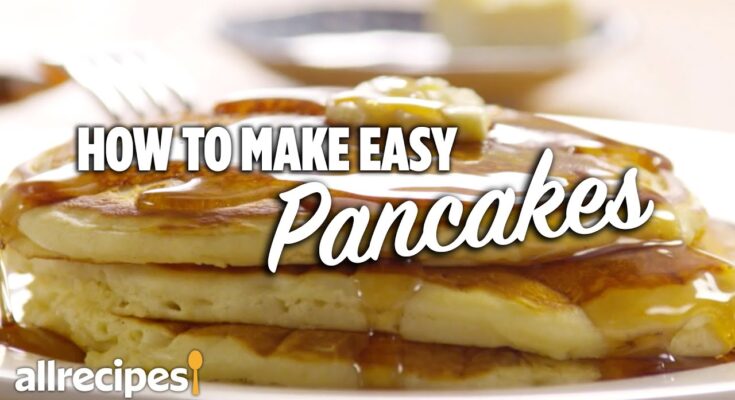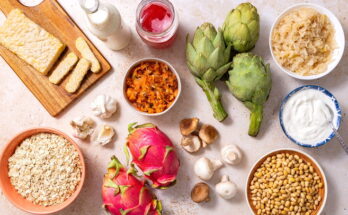Pancakes Recipe: Pancakes are a classic breakfast staple that are loved around the world for their simplicity, versatility, and irresistible taste.
Whether you’re making them for a weekend family brunch or as a cozy breakfast treat, pancakes are easy to make, and with a few essential ingredients, you’ll have a fluffy, delicious stack ready in no time.
This guide walks you through each step, helping you master the art of perfect pancakes every time.
Ingredients for Basic Pancakes
Before diving into the steps, let’s gather the ingredients needed to make a batch of classic pancakes. These simple items are likely already in your kitchen:
- 1 cup all-purpose flour
- 2 tablespoons sugar
- 1 tablespoon baking powder
- 1/2 teaspoon salt
- 3/4 cup milk (use whole milk or adjust as needed for preference)
- 1 large egg
- 2 tablespoons melted butter (plus extra for cooking)
Tips:
- Use fresh ingredients to ensure the best flavor and texture.
- For added flavor, consider a teaspoon of vanilla extract.
Kitchen Tools You’ll Need
Having the right tools on hand can make pancake-making much smoother. Here’s what you’ll need:
- Mixing bowls – for combining wet and dry ingredients separately.
- Whisk or fork – to mix the batter without lumps.
- Measuring cups and spoons – for accurate measurements.
- Non-stick skillet or griddle – for even cooking.
- Spatula – a flexible, flat spatula makes flipping easier.
Tips:
- A non-stick skillet is ideal as it minimizes the need for excess butter or oil.
- Use a spatula that’s the right size for the pancakes to avoid damaging the shape while flipping.
Preparing the Batter
The key to perfect pancakes is in the batter. Follow these steps to get it just right:
- Combine Dry Ingredients: In a medium bowl, whisk together the flour, sugar, baking powder, and salt. This ensures that all the dry ingredients are well-mixed.
- Mix Wet Ingredients: In a separate bowl, whisk together the milk, egg, and melted butter until smooth. Adding melted butter at this stage helps incorporate it evenly throughout the batter.
- Combine Wet and Dry Ingredients: Pour the wet ingredients into the dry ingredients. Use a whisk or fork to gently mix until combined. The batter should have small lumps—overmixing will lead to tougher pancakes.
Tips:
- Let the batter rest for a few minutes to allow the flour to absorb the liquid. This can improve the fluffiness of your pancakes.
Tips for Achieving Fluffy Pancakes
If you’ve ever wondered how to get that light, airy texture, here are a few tips:
- Don’t Overmix the Batter: Overmixing activates the gluten in flour, making pancakes tough. Mix until just combined.
- Use Fresh Baking Powder: Baking powder loses potency over time, affecting the rise of your pancakes. Fresh baking powder ensures a fluffier stack.
- Let the Batter Rest: A 5-10 minute rest time helps the gluten relax and allows air bubbles to form, contributing to fluffiness.
Pro Tip:
- Add a tablespoon of plain yogurt or buttermilk to the batter for extra softness.
Choosing the Right Pan and Heat Setting
The type of pan and heat level you use can significantly impact the quality of your pancakes:
- Pan Selection: A non-stick skillet or griddle is ideal for pancakes as it prevents sticking and allows for even browning.
- Heat Setting: Medium-low heat is best. Too high, and the pancakes will brown too quickly on the outside while remaining raw inside; too low, and they may not brown enough.
Tips:
- Preheat the pan for a few minutes to ensure even cooking.
- Test the pan’s heat by sprinkling a few drops of water on it. If the drops sizzle, the pan is ready for batter.
Cooking the Pancakes
Now, onto the main event: cooking your pancakes!
- Add Butter to the Pan: Lightly coat the pan with butter. A small amount is enough to prevent sticking without making the pancakes greasy.
- Pour the Batter: Pour a ladleful (about 1/4 cup) of batter onto the pan for each pancake. Spread the batter slightly with the back of the ladle to shape.
- Wait for Bubbles: Cook until bubbles start forming on the surface of the pancakes, which should take about 2-3 minutes.
- Flip: Use a spatula to gently lift the pancake and flip it over. Cook for another 1-2 minutes or until golden brown.
Tips:
- Only flip each pancake once to avoid losing fluffiness.
- Avoid pressing down on the pancake after flipping, as this releases air and makes it dense.
How to Flip Pancakes Perfectly
Flipping can feel tricky, but with a little practice, you’ll master it:
- Use a Flexible Spatula: This makes it easier to slide under the pancake without breaking it.
- Watch for Bubbles: Bubbles and slightly dry edges are signs the pancake is ready to flip.
- Quick Flip Motion: Slide the spatula under, lift quickly, and turn in one swift motion.
Pro Tip:
- Keep the pancake size manageable for easier flipping, especially if you’re a beginner.
Keeping Pancakes Warm While Cooking Batches
If you’re making multiple pancakes, keeping them warm without losing their fluffiness is essential:
- Use an Oven: Preheat the oven to 200°F (93°C) and place cooked pancakes on a baking sheet in the oven.
- Cover with Foil: If you don’t have an oven, cover the pancakes with foil to retain warmth.
Tips:
- Don’t stack hot pancakes immediately, as they may lose their texture. Instead, arrange them in a single layer in the oven.
Adding Variations to the Basic Recipe
Want to get creative? Try these add-ins:
- Chocolate Chips: Add chocolate chips directly into the batter for a sweet twist.
- Fresh Berries: Add blueberries, strawberries, or raspberries for a fruity touch.
- Cinnamon Swirl: Mix cinnamon and sugar, then swirl it into each pancake for extra flavor.
Pro Tip:
- To prevent fruit or chocolate chips from sinking, lightly coat them with flour before adding to the batter.
Topping Ideas for Pancakes
Once your pancakes are ready, it’s time for toppings. Classic and creative toppings can transform your pancakes into something truly special. Here are a few popular choices:
- Classic Syrup and Butter: Drizzle maple syrup and add a pat of butter for a traditional pancake experience.
- Fresh Fruit and Whipped Cream: Top with sliced strawberries, blueberries, or bananas, along with a dollop of whipped cream for a refreshing twist.
- Powdered Sugar Dusting: A light sprinkle of powdered sugar adds sweetness and a lovely presentation.
- Nut Butter and Honey: Spread almond or peanut butter over your pancake stack, then drizzle with honey for a protein-packed treat.
- Yogurt and Nuts: Try topping with a spoonful of Greek yogurt and sprinkle of nuts like almonds or walnuts for added texture and flavor.
- Chocolate Sauce or Nutella: For chocolate lovers, a drizzle of chocolate sauce or a spread of Nutella makes pancakes rich and indulgent.
Tip:
- Mix and match toppings for your unique creation. You could even create a pancake bar with different toppings for a fun family breakfast.
Serving Suggestions and Presentation Tips
Presentation matters, especially if you’re serving guests. Here are a few tips to serve pancakes in a visually appealing way:
- Stack ‘Em Up: Stack pancakes in a neat pile, creating a delicious tower. This keeps them warm and makes for an inviting presentation.
- Add Toppings Beautifully: Arrange fruit, nuts, or whipped cream on top in an attractive way. Fresh berries or sliced bananas add a vibrant pop of color.
- Drizzle Sauces Artfully: Pour syrup, chocolate, or caramel sauce in a zigzag pattern on top of the pancakes. This not only looks beautiful but also spreads the flavor evenly.
- Serve with Sides: Pancakes pair well with breakfast sausages, scrambled eggs, or a bowl of fresh fruit. Arrange sides on a plate with the pancake stack for a complete meal.
- Use Garnishes: Fresh mint leaves, a sprinkle of powdered sugar, or a slice of orange on the side adds a decorative touch.
Pro Tip:
- Warm your plates before serving pancakes. This keeps them warm longer, especially if your stack is tall!
Troubleshooting Common Pancake Problems
Not every pancake-making experience goes smoothly. Here are solutions to a few common issues:
- Pancakes are Flat: If your pancakes aren’t rising, it could be due to old or insufficient baking powder. Always use fresh baking powder, and ensure you’ve added the right amount.
- Rubbery Texture: Overmixing the batter can result in rubbery, tough pancakes. Mix just until ingredients are combined, leaving small lumps.
- Uneven Cooking or Browning: This often occurs when the heat is too high. Adjust to medium-low heat for consistent browning.
- Pancakes Stick to the Pan: If your pancakes are sticking, ensure you’re using a good non-stick pan or adding a bit more butter/oil.
- Batter Too Thin or Too Thick: If your batter is too thin, add a little more flour. If it’s too thick, add a small splash of milk until it reaches the right consistency.
Tip:
- Test the batter consistency by cooking a small “test pancake” first. This lets you make adjustments before cooking the whole batch.
Nutritional Value and Tips for Healthier Pancakes
Basic pancakes are made from flour, milk, eggs, and butter, providing a combination of carbohydrates, protein, and fat. Here’s a breakdown:
| Nutrient | Per Pancake (approximate) |
|---|---|
| Calories | 85 |
| Protein | 2.5g |
| Carbohydrates | 12g |
| Fats | 2.5g |
| Fiber | 1g |
If you’re looking to make healthier pancakes, here are some modifications:
- Use Whole Wheat Flour: Substitute part or all of the all-purpose flour with whole wheat flour for added fiber.
- Choose Non-Dairy Milk: Try almond milk, oat milk, or soy milk to make the recipe dairy-free.
- Cut Down on Sugar: Reduce the amount of sugar or use natural sweeteners like honey or maple syrup.
- Add Protein Powder or Greek Yogurt: For a protein boost, add a scoop of protein powder or a few tablespoons of Greek yogurt to the batter.
- Add Fruits or Vegetables: Shredded zucchini, mashed bananas, or pumpkin purée add flavor and nutrition.
Pro Tip:
- Pancakes made with oat flour, eggs, and a mashed banana are a gluten-free, high-protein option!
FAQs about Pancake Recipe
Q1: What ingredients do I need for fluffy pancakes?
To make fluffy pancakes, you’ll need flour, baking powder, sugar, salt, milk, eggs, and melted butter. These ingredients work together to create the light and airy texture that makes pancakes fluffy.
Q2: How do I make my pancakes extra fluffy?
For extra fluffy pancakes, try sifting the dry ingredients and letting the batter rest for 5–10 minutes before cooking. This resting period allows the baking powder to activate, resulting in thicker, fluffier pancakes.
Q3: Can I use whole wheat flour instead of all-purpose flour?
Yes, you can use whole wheat flour, but it may make the pancakes denser. To balance the texture, try using half whole wheat and half all-purpose flour.
Q4: How do I prevent my pancakes from sticking to the pan?
Use a non-stick skillet or griddle and add a light coating of oil or butter. Make sure the pan is hot before pouring in the batter to prevent sticking.
Q5: What’s the best way to tell when to flip a pancake?
Look for bubbles forming on the surface of the pancake, especially around the edges. Once the bubbles pop and the edges look set, it’s time to flip.
Q6: Can I freeze leftover pancakes?
Yes, pancakes freeze well! Let them cool completely, then stack them with wax paper in between each one. Place them in an airtight container or freezer bag and freeze for up to three months.
Conclusion
Making pancakes from scratch is a rewarding experience. This step-by-step guide simplifies the process, from preparing the batter to adding delicious toppings. Whether you stick to the basic recipe or try new variations, pancakes offer endless possibilities to suit every taste. Gather your ingredients, get your pan ready, and enjoy a breakfast that’s made with love. Nothing compares to the warm, fluffy stack of homemade pancakes, topped just the way you like.
References
For those looking to delve deeper into the art of making fluffy pancakes, here are some trusted sources that provide additional insights and variations. These references can help validate the techniques and ingredients mentioned in this recipe, ensuring that you have all the details needed to perfect your pancakes. Explore the links below for expert tips, alternative recipes, and more detailed explanations:
- Allrecipes – Fluffy Pancakes Recipe
- Food Network – Best Pancake Recipes
- Bon Appétit – Guide to Perfect Pancakes
These resources offer diverse perspectives and tested methods, allowing you to expand your pancake-making skills with confidence.



